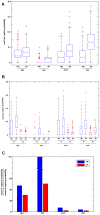Positional signaling and expression of ENHANCER OF TRY AND CPC1 are tuned to increase root hair density in response to phosphate deficiency in Arabidopsis thaliana
- PMID: 24130712
- PMCID: PMC3794009
- DOI: 10.1371/journal.pone.0075452
Positional signaling and expression of ENHANCER OF TRY AND CPC1 are tuned to increase root hair density in response to phosphate deficiency in Arabidopsis thaliana
Abstract
Phosphate (Pi) deficiency induces a multitude of responses aimed at improving the acquisition of Pi, including an increased density of root hairs. To understand the mechanisms involved in Pi deficiency-induced alterations of the root hair phenotype in Arabidopsis (Arabidopsis thaliana), we analyzed the patterning and length of root epidermal cells under control and Pi-deficient conditions in wild-type plants and in four mutants defective in the expression of master regulators of cell fate, CAPRICE (CPC), ENHANCER OF TRY AND CPC 1 (ETC1), WEREWOLF (WER) and SCRAMBLED (SCM). From this analysis we deduced that the longitudinal cell length of root epidermal cells is dependent on the correct perception of a positional signal ('cortical bias') in both control and Pi-deficient plants; mutants defective in the receptor of the signal, SCM, produced short cells characteristic of root hair-forming cells (trichoblasts). Simulating the effect of cortical bias on the time-evolving probability of cell fate supports a scenario in which a compromised positional signal delays the time point at which non-hair cells opt out the default trichoblast pathway, resulting in short, trichoblast-like non-hair cells. Collectively, our data show that Pi-deficient plants increase root hair density by the formation of shorter cells, resulting in a higher frequency of hairs per unit root length, and additional trichoblast cell fate assignment via increased expression of ETC1.
Conflict of interest statement
Figures






Similar articles
-
The paralogous R3 MYB proteins CAPRICE, TRIPTYCHON and ENHANCER OF TRY AND CPC1 play pleiotropic and partly non-redundant roles in the phosphate starvation response of Arabidopsis roots.J Exp Bot. 2015 Aug;66(15):4821-34. doi: 10.1093/jxb/erv259. Epub 2015 May 28. J Exp Bot. 2015. PMID: 26022254 Free PMC article.
-
Localization of ENHANCER OF TRY AND CPC1 protein in Arabidopsis root epidermis.J Plant Physiol. 2017 Jul;214:48-52. doi: 10.1016/j.jplph.2017.04.001. Epub 2017 Apr 4. J Plant Physiol. 2017. PMID: 28437677
-
The ENHANCER OF TRY AND CPC1 gene acts redundantly with TRIPTYCHON and CAPRICE in trichome and root hair cell patterning in Arabidopsis.Dev Biol. 2004 Apr 15;268(2):506-13. doi: 10.1016/j.ydbio.2003.12.037. Dev Biol. 2004. PMID: 15063185
-
[The mechanism of root hair development and molecular regulation in plants].Yi Chuan. 2007 Apr;29(4):413-9. doi: 10.1360/yc-007-0413. Yi Chuan. 2007. PMID: 17548302 Review. Chinese.
-
Cell-fate specification in the epidermis: a common patterning mechanism in the root and shoot.Curr Opin Plant Biol. 2003 Feb;6(1):74-8. doi: 10.1016/s136952660200002x. Curr Opin Plant Biol. 2003. PMID: 12495754 Review.
Cited by
-
Integration of P, S, Fe, and Zn nutrition signals in Arabidopsis thaliana: potential involvement of PHOSPHATE STARVATION RESPONSE 1 (PHR1).Front Plant Sci. 2015 Apr 28;6:290. doi: 10.3389/fpls.2015.00290. eCollection 2015. Front Plant Sci. 2015. PMID: 25972885 Free PMC article. Review.
-
Effect of phosphate starvation on CAPRICE homolog gene expression in the root of Arabidopsis.Plant Biotechnol (Tokyo). 2020 Sep 25;37(3):349-352. doi: 10.5511/plantbiotechnology.20.0226a. Plant Biotechnol (Tokyo). 2020. PMID: 33088199 Free PMC article.
-
Discriminative gene co-expression network analysis uncovers novel modules involved in the formation of phosphate deficiency-induced root hairs in Arabidopsis.Sci Rep. 2016 May 25;6:26820. doi: 10.1038/srep26820. Sci Rep. 2016. PMID: 27220366 Free PMC article.
-
Root hairs.Arabidopsis Book. 2014 Jun 25;12:e0172. doi: 10.1199/tab.0172. eCollection 2014. Arabidopsis Book. 2014. PMID: 24982600 Free PMC article.
-
Cellular Patterning of Arabidopsis Roots Under Low Phosphate Conditions.Front Plant Sci. 2018 Jun 5;9:735. doi: 10.3389/fpls.2018.00735. eCollection 2018. Front Plant Sci. 2018. PMID: 29922313 Free PMC article.
References
-
- Dolan L, Janmaat K, Willemsen V, Linstead P, Poethig S, et al. (1993) Cellular organisation of the Arabidopsis thaliana root. Development 119: 71–84. - PubMed
-
- Costa S, Dolan L (2000) Development of the root pole and cell patterning in Arabidopsis roots. Current Opinion in Genetics and Development 10: 405–409. - PubMed
-
- Clowes FAL (2000) Pattern in root meristem development in angiosperms. New Phytologist 146: 83–94.
-
- Leavitt RG (1904) Trichomes of the root in vascular cryptogams and angiosperms: Harvard University.
Publication types
MeSH terms
Substances
Grants and funding
LinkOut - more resources
Full Text Sources
Other Literature Sources
Molecular Biology Databases
Research Materials
Miscellaneous

